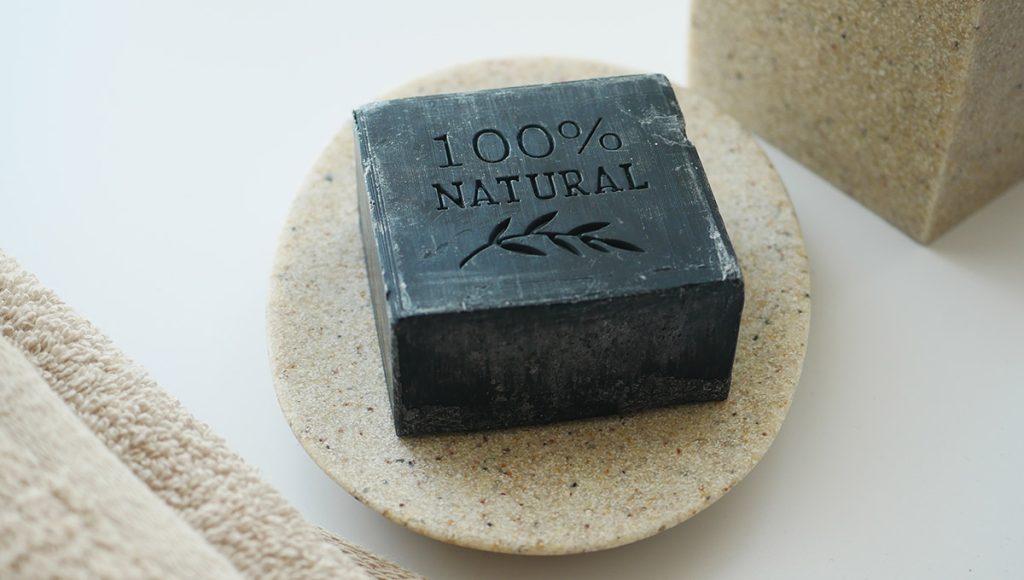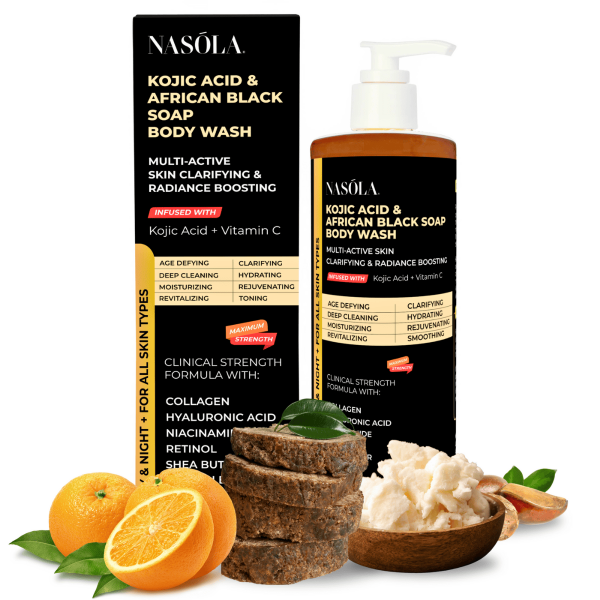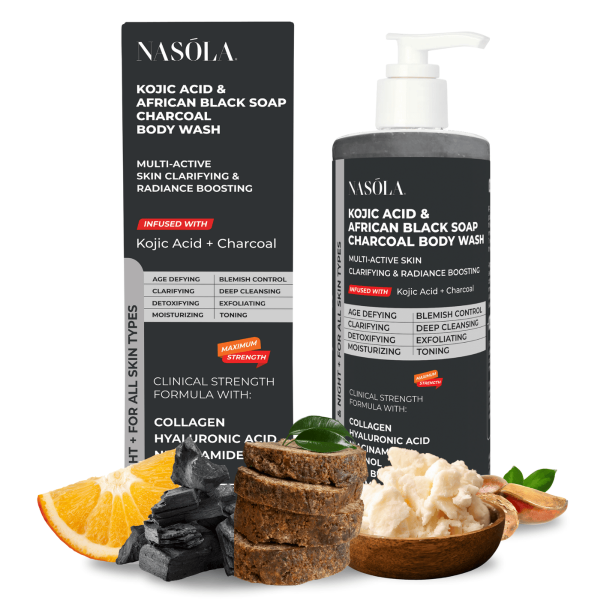African black soap is rewriting skincare routines worldwide—and it’s about time. Known for its raw, earthy texture and blend of skin-loving ingredients, African black soap has found its way into vanities and shower shelves everywhere.
If you’ve ever asked yourself how to use African black soap the right way to actually see results, buckle in—we’ve got you.
Whether you’re struggling with acne scars, oily skin, or those stubborn dark spots that love to overstay their welcome, this deep-diving guide will walk you through the do’s (and avoid-the-drama don’ts).
Plus, we’ll introduce you to the Nasola Kojic Acid African Black Soap Body Wash—a cleaner, gentler, supercharged version of this traditional powerhouse that’s been a game-changer for many of my readers and clients.
Let’s get into the suds and secrets, shall we?
- How to Use African Black Soap Correctly in Your Skincare Routine
- The Benefits of Using African Black Soap
- Understanding Skin Type Compatibility
- African Black Soap for Acne and Dark Spots
- Common Mistakes in Using African Black Soap
- Ingredient Spotlight: Kojic Acid
- Unique Ways to Use African Black Soap in Self-Care
- Building Habits Around How to Use African Black Soap for Long-Term Results
- Conclusion
- FAQs: How to Use African Black Soap
How to Use African Black Soap Correctly in Your Skincare Routine
Mastering how to use African black soap can feel a bit intimidating at first—especially if you’ve ever tried the raw version and ended up with tight, squeaky skin.
But the trick is knowing how and when to use it so you can enjoy all the benefits with none of the fuss.
Here’s what we always tell new users: Start slow. There’s no gold medal for diving in head-first and scrubbing like your future depends on it. African black soap is potent! The best approach? A gentle start.
Step-by-Step Guide to Using African Black Soap
A lot of skin irritation starts from misuse, not the soap itself. So here’s how to get it right:
- Wet your bath sponge or a washcloth first—don’t go rubbing raw soap directly onto your skin.
- Create a gentle lather. A little goes a long way!
- Apply the foam to damp skin. Massage in circular motions for no more than 20–30 seconds on your face.
- Rinse thoroughly with warm (not hot!) water.
For your body, feel free to apply a bit longer, especially on breakout-prone or discolored areas.
Then follow with moisturizer. ALWAYS.
Just a few tries in, and you’ll notice not only smoother skin—but a quiet confidence creeping in.
African Black Soap with Kojic Acid for a Brighter Complexion
Traditional African black soap pulls out the gunk. But what if it could lighten the mood (and the skin tone) too?
That’s where the Nasola Kojic Acid African Black Soap Body Wash earns its praise. It revolutionizes the experience by blending authentic African black soap with kojic acid—a natural brightener that fades dark patches and hyperpigmentation.
So if you’re dreaming of even skin tone or aching for clarity post-acne, this wash wraps up both goals in one silky formula.
No flakes, no over-dryness. Just clean, balanced glow.
The Benefits of Using African Black Soap

Trying African black soap isn’t just about trends. The benefits? Oh. They’re real, juicy, and transformative when used properly. Think of it as nature’s cleanser-meets-skin-rejuvenator.
Here’s why.
When used consistently (and respectfully, might I add), African black soap can turn dull, overworked skin into a smoother, even canvas—all without stripping your natural oils.
Why African Black Soap is a Must-Have in Your Skin Routine
Your skin wants simplicity. African black soap brings that, powered by plantain skins, cocoa pods, and nourishing butters.
Here’s what it brings to your skincare A-team:
- Deep-cleanses pores while preserving essential hydration.
- Helps regulate oil production naturally.
- Buffs away dull skin through gentle exfoliation.
- Soothes irritation linked to eczema and minor breakouts.
Done right, you’ll experience fewer flakes, reduced oil, and an all-around brighter reflection. Isn’t that what we’re all chasing?
Kojic Acid’s Role in Skin Brightening
Enter kojic acid—an MVP among glow-getters. Derived from fermented rice, it silently tackles dark spots and melanin buildup by gently fading scars, sun spots, and irritating reminders of past breakouts.
Paired with African black soap in Nasola’s formula, kojic acid boosts:
- Dark spot fading within a few weeks.
- Smoother, fresher skin texture.
- Gradual skin lightening, not in a bleachy way (ick!), but in a healthy, radiant one.
- Confidence-building clarity with every use.
All this—inside an easy-pump bottle. Because who really has time for raw bars melting on your shower ledge??
Understanding Skin Type Compatibility
Here’s the moment of truth: not every skin reacts the same way to African black soap. But the good news? If used wisely, everyone can benefit. It just might need a few tweaks based on your skin type.
This section is for those who’ve ever asked, “But… is it too harsh for me?” (Spoiler: Not if you do it right.)
Dry Skin Considerations
Dry skin doesn’t mean African black soap is off the table—it just means your BFF is a moisturizer afterward.
Raw versions of black soap can be slightly too aggressive on dry patches. Which is why I often recommend ditching the raw and going for something infused—like Nasola Kojic Acid African Black Soap Body Wash. It maintains all the healing properties of the original while being:**
- Much gentler on compromised skin barriers.
- Infused with hydrating agents that nourish as you cleanse.
- Better suited for regular use without irritation.
- Smoother during application—less tugging and tearing.
The benefits without the backlash. That’s what we love.
Oily/Acne-Prone Skin Power
Now if you’re on the oilier side or have stubborn breakouts, African black soap becomes your best cleanser secret.
It naturally cuts through oil and leaves behind balance. Not tightness. Not flakes.
Here’s how it helps:
- Removes surface oil and dirt more effectively than many harsh foams.
- Contains antibacterial ingredients that slow acne-causing bacteria.
- Soft natural exfoliation—say goodbye to whiteheads!
- Reduces overactive pores with short-term and long-term use.
The result? Skin that feels detoxified and clean—but never panicked.
African Black Soap for Acne and Dark Spots

This section? It’s for everyone who’s stared in the mirror and sighed, “WILL these spots ever go away??“
I feel you, deeply. Breakouts are annoying. But the lingering scars after the fact? EVEN MORE.
Using African black soap for these skin hurdles is like equipping yourself with a well-trained skincare soldier.
Acne Treatment Benefits
First, let’s talk about your breakouts. African black soap combats blemishes by tackling the trio of doom:
- Excess oil.
- Bacteria overload.
- Clogged pores.
It gets to the root cause, especially when used regularly. Here are the biggest takeaways:
- Dries up active breakouts (but not your entire face… whew!)
- Prevents future breakouts with deep pore sweeping.
- Reduces redness and swelling.
- Gives your skin that post-detox fresh clarity vibe.
Paired with a calming moisturizer? Magic!
Scars and Hyperpigmentation Support
Okay, now for the post-acne tough guys: the scars, the spots, the trauma.
The kojic acid in Nasola’s body wash changes the game completely:
- Brightens skin tone with consistent use.
- Breaks down dark spot discoloration.
- Helps even out patches from hormonal acne.
- Reveals smoother-looking skin without bleaching!
Patience and commitment. These two paired with the Nasola Kojic Acid African Black Soap Body Wash? That’s how fading happens consistently.
Common Mistakes in Using African Black Soap
Here’s a curveball: Sometimes it’s not the product, it’s the user errors keeping results at bay. Let’s fix that.
I’ve seen many great skincare routines ruined by over-zealous scrubbing and soggy soap storage. So we’re laying out the truth here.
Avoiding Overuse and Irritation
African black soap is mighty—but can cause issues if misused. Here’s what not to do:
- Don’t apply raw soap directly on your skin.
- Don’t exceed 30 seconds on your face during early use.
- Don’t scrub harshly—your skin isn’t grout tile!
- Don’t forget to follow up with a soothing, hydrating moisturizer.
Your skin wants guidance, not punishment!
Choosing Between Raw and Body Wash Versions
Confused between the raw bar and body wash? Let’s ease the mental clutter.
Opting for a product like Nasola Kojic Acid African Black Soap Body Wash gives you:
- Pre-blended, controlled concentration of active ingredients.
- Easier application and no risk of leftover chunks.
- Balanced pH to avoid over-drying.
- Cleaner storage—no sticky puddles left on your soap dish!
Smart skin is simple skin.
Ingredient Spotlight: Kojic Acid

Did I mention how obsessed I am with kojic acid when it comes to skin brightening? Because 😍
It’s like the quiet achiever of skincare. Often overlooked, but oh-so-potent when allowed to do its thing.
How Kojic Acid Enhances African Black Soap
Here’s how it’s leveling up your glow:
- Suppresses excess melanin production.
- Helps diminish acne scars, sun spots, age spots, and that random patch on your cheek.
- Boosts cell turnover for revitalized skin.
- Provides a low-key antioxidant punch to delay aging signs.
When batched inside something hydrating like Nasola’s formula, this ingredient gets to work—delicately, but effectively.
Best Way to Use Kojic Acid with African Black Soap
Still skeptical? Don’t worry.
Using the Nasola Kojic Acid African Black Soap Body Wash is a safe, effective delivery system. It:
- Ensures every drop has mild, even levels of kojic acid.
- Can be used 2–5 times per week.
- Doesn’t irritate like raw soap sometimes can.
- Works faster thanks to evenly distributed ingredients.
Glow up made easy. That’s what science + nature gives us.
Unique Ways to Use African Black Soap in Self-Care
Just when you thought African black soap was limited to face and body… surprise! There are more ways to love it.
These unexpected uses might just change how you use African black soap forever.
As a Shaving Aid
Ever shaved and ended up with bumps, razor burn, or the rash of doom? Yeah—me too.
Using African black soap instead of traditional shave foams helps because:
- It creates a soft, non-irritating barrier.
- Reduces inflammation common after shaving.
- Helps exfoliate dead skin pre-shave.
- Prevents follicle blockage = less ingrown hairs.
Start with legs or beard area and see the magic.
As a Clarifying Scalp Cleanser
Product buildup, itchy scalp, dry flakes? Cue in African black soap.
Here’s how:
- Mix soap with warm water to create a diluted rinse.
- Apply gently to scalp and massage for 2–5 minutes.
- Rinse and follow with conditioner.
- Use once per week for best results.
Suddenly your scalp’s as happy as your face 🧖🏽
Building Habits Around How to Use African Black Soap for Long-Term Results
Glow isn’t born, it’s built—one mindful habit at a time.
Understanding how to use African black soap correctly is more of a lifestyle move than a one-and-done trend.
Consistency is Queen (and King)
- Stick to 2–3 uses per week for sensitive skin, or work up to daily use for oily skin.
- Always moisturize afterward to lock in moisture.
- Be patient; full glow-up can take 4–8 weeks.
- Use Nasola’s Kojic Acid Body Wash version to reduce trial-and-error.
Pairing with the Right Products
To get the most out of black soap:
- Use with a clean exfoliating glove once a week.
- Avoid pairing with harsh acidic toners.
- Follow with serums aimed at your skin goals.
- Keep a gentle moisturizer as the final step.
This is how skin transformation happens—one caring step after another.
Conclusion
By now, your step-by-step guide on how to use African black soap isn’t just informational—it’s empowering.
Remember, black soap offers real benefits for all skin types: from unblocking pores and calming inflammation to brightening dark spots and boosting your skin’s confidence.
With professionally balanced products like the Nasola Kojic Acid African Black Soap Body Wash, you unlock all these benefits with less risk and more satisfaction.
So go ahead—say yes to clear, confident skin.
And make your mirror your cheerleader again ❤️
FAQs: How to Use African Black Soap
Yes, you can—if your skin allows it. People with oily or acne-prone skin often find great results with daily use. But if you’re dry, start with 2-3 times per week. Listen to your skin and adjust accordingly.
We highly recommend the Nasola Kojic Acid African Black Soap Body Wash. It combines traditional soap ingredients with kojic acid, which is proven to fade dark spots and even skin tone with consistent use.
Yes—but use it gently. Never rub raw black soap bar directly on your face. Instead, lather it in your palms or with a cloth, with applications lasting no longer than 30 seconds initially.
Sometimes there’s a purging phase, especially during the first week. This happens as your pores clear out. Continue regular, moderated use and your skin will usually improve by week two.
Definitely. Dilute the soap with water or use a formulated version like Nasola’s and apply to the scalp once a week. Massage gently, rinse thoroughly, and follow with conditioner to avoid dryness.
Absolutely! Whether you have oily or dry skin, always follow with a moisturizer. African black soap can make your skin feel tight if left without hydration.
Of course! Men love Nasola’s version especially since it simplifies their grooming routines. It’s effective for acne, razor bumps, and even scalp care.
Yes. It’s particularly effective for body acne due to its antibacterial and deep-cleaning properties. Pair with a soft exfoliating glove and use it 2–4 times a week for best results.



